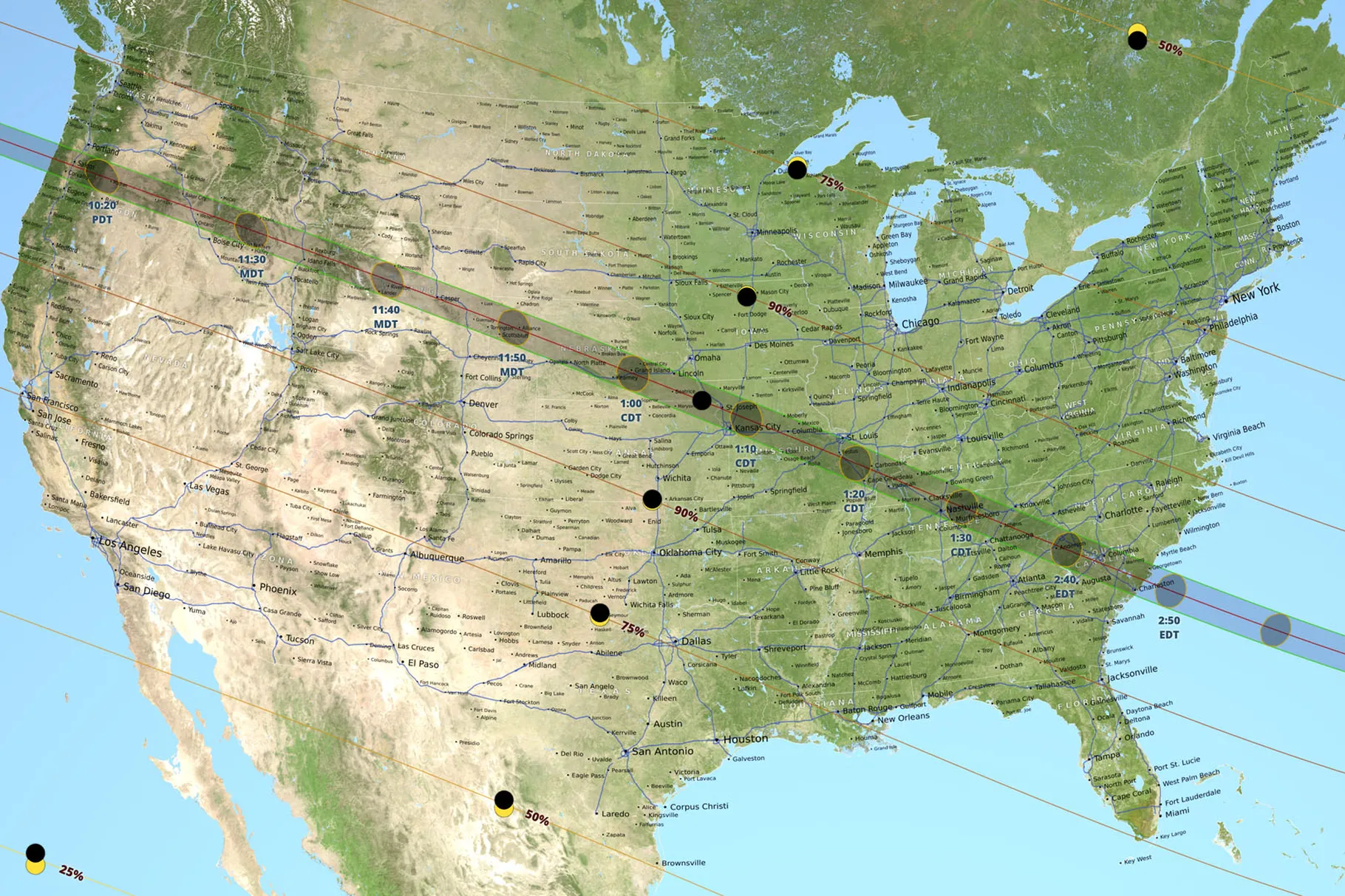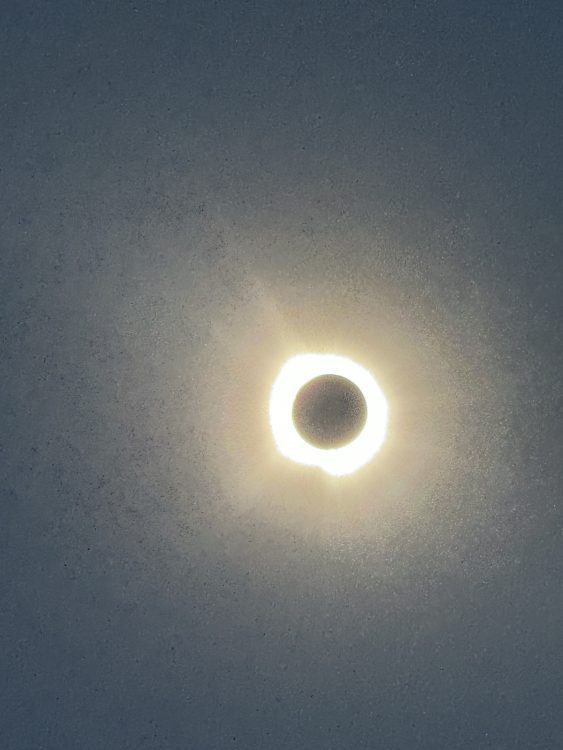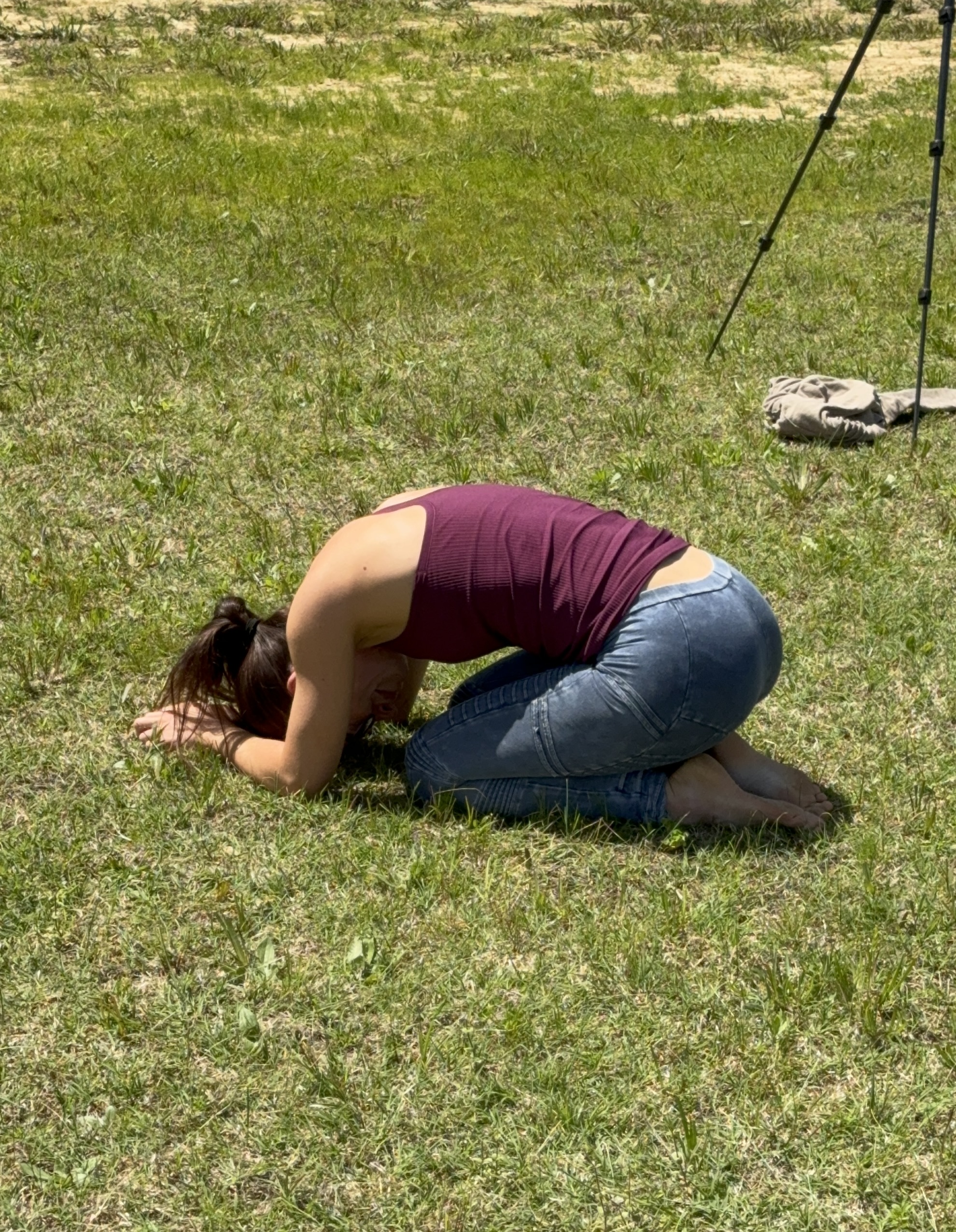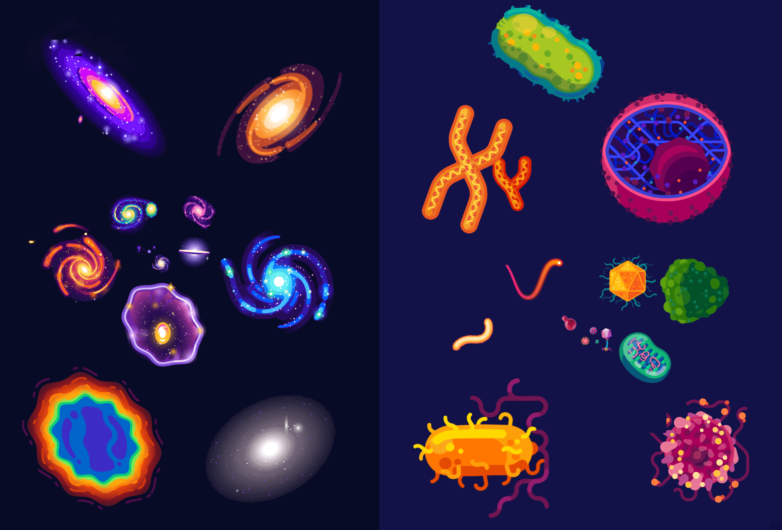In 2017, I did something dumb. There was a total solar eclipse passing through the US, but I was in NYC, far from the path. Was I really gonna get on a plane to see a cool thing for two minutes? Nah. I had shit to do.1
The day came. I put my stupid glasses on and saw the sun become a little less big and then back to being full size again. It was mildly interesting.
Then the reports started coming in from the people who had seen it from the totality zone. People were like “it was an indescribably profound, perspective-shifting, life-altering experience.” They were like “I’m a different person now, someone who can only be understood by other people who saw the total solar eclipse.” It was massively FOMOy and upsetting.
Solar eclipses happen when the moon passes directly through the invisible line connecting the sun and Earth, something that doesn’t happen very often because space is big and the invisible line is skinny. Here’s a very not-to-scale diagram2 (to make it to scale, picture the sun being a basketball on one side of the basketball court, the Earth being a 2mm-diameter pebble on the other side of the court, and the moon being a small grain of sand about 7cm away from the pebble).
Earthlings are very lucky, eclipse-wise. Most planets don’t have a big enough moon to create a total solar eclipse. Not only is our moon big enough, it’s about exactly the size of the sun in our night sky because, by sheer coincidence, the sun is about 400 times farther from us than the moon and also about 400 times bigger than the moon in diameter—making our eclipses especially breathtaking.
There are about 70 total solar eclipses every century, each resulting in a thin path of total sun blockage. For most of history, there was no way to know when or where they would happen. Only the very lucky few who happened to be in the right place, at the right time, with the right weather, got to experience a total solar eclipse. Today you can ensure that you see one—and I had passed up the opportunity. I would not be making the mistake again.
I went online and learned that there would be another total solar eclipse passing through the US in 2024, and then that would be it until 2045.1 It went on my calendar that day.
As fortune would have it, the 2024 eclipse’s path of magical totality would be passing right over my new hometown of Austin, Texas. It was perfect.
Then came the weather reports. Austin was going to be cloudy on eclipse day.
Nope. Not okay. It wasn’t an option to not see this eclipse. My friend Liv Boeree was equally psychotic about this, so we decided on Sunday night that Monday morning we’d get on a flight to somewhere in the eclipse’s path that was forecast to have clear skies. We settled on Arkansas.
Early the next morning we flew to Little Rock where we were joined by our friend Peter, got in a car, and drove northwest to the dead center of the totality path, where the total eclipse would last for more than four minutes. We ended up in a big open rural field that may or may not have been part of someone’s farm. It was us and some cows. The sky was perfectly clear.
30 minutes until totality. I looked through my glasses at a crescent sun. It seemed a little dimmer out than usual, but only a little.
20 minutes. Thinner crescent, a tad dimmer, maybe slightly cooler than it was before?
10 minutes. Razor-thin crescent now, definitely weird lighting. Because all of the light is coming from one small area, shadows are very sharp. You can see the shadow of individual hairs on your head.
1 minute. It’s very dim, like early evening, but still feels like daytime generally. Waves of light and dark ripple across the ground, like the way light moves at the bottom of a swimming pool.
5 seconds. Diamond ring! I take off my glasses and the diamond ring looks strikingly beautiful and strange.
4, 3, 2, 1. The Earth’s dimmer switch suddenly goes downnnnn as dim daylight drops into night.
Totality.
Imagine a world where there was always cloud cover, and one day every few years, in certain places, the sky cleared at night, and you could see stars for the first time in your life. It would be a totally surreal experience, something that reminded you that you don’t live in a big world but on the edge of a tiny rock in vast outer space. It would show you the truth about reality.
We see stars all the time, so we’re well-acquainted with our reality living in outer space (even if it’s easy to forget during the day). But when I looked up at the sky during the total eclipse, it was the first time I had experienced another, totally different way to see with my eyes that I lived in outer space. I saw one sphere positioned in front of another sphere, with two other spheres—Venus and Jupiter—floating nearby. More than ever before, it felt obvious that I was standing on the edge of a fifth sphere. For the first time in my life, I was looking at the Solar System.
I looked around. It was dark. At 2pm. There was a 360° sunset along the entire horizon—another first. By a minute in, there was a chorus of chirping crickets that hadn’t been there before. Birds were flying around overhead that hadn’t been there before. The cows continued being cows but I assume they were super confused.
I looked back up at the Solar System and noticed a little imperfection on the edge of the black moon circle, which I later learned was a solar prominence. A solar prominence I could see with my naked eye.
Only half of my brain was focused on the eclipse because the other half was frantically trying to figure out how to best use the precious minutes. I told myself I wouldn’t spend more than 30 seconds doing stuff with my camera, but I was not gonna not take pics. I got things all focused and snapped this gem:
Just kidding that’s Andrew McCarthy‘s photo. But mine was pretty good too:
Okay fine that one is from NASA.3 Here’s my actual photo:
Whatever. Anyway, eventually it ended. The glorious diamond ring reappeared, followed by me being blinded before remembering to not look at the sun anymore. Earth’s dimmer switch swooped back up, as night turned to day in a few surreal seconds. It was over.
Thoughts were processed. Emotions were felt.
It was very very VERY worth the last-second trip. For any of you who pulled a 2017 Tim and decided not to see this one, I hope I’ve sufficiently FOMOed you into making sure you see this for yourself, sometime soon, in some part of the world. 🌻
___________
More from the cosmos:
How (and Why) SpaceX Will Colonize Mars
_______
If you like Wait But Why, sign up for our email list and we’ll send you new posts when they come out.
To support Wait But Why, visit our Patreon page.
Technically, there will also be a solar eclipse passing through the US in 2044, but it barely scrapes the country and happens close to sunset↩











